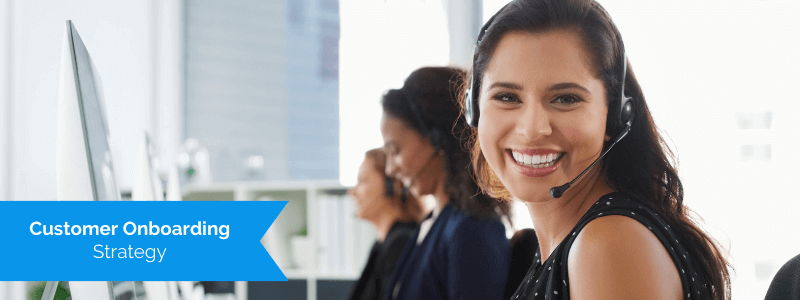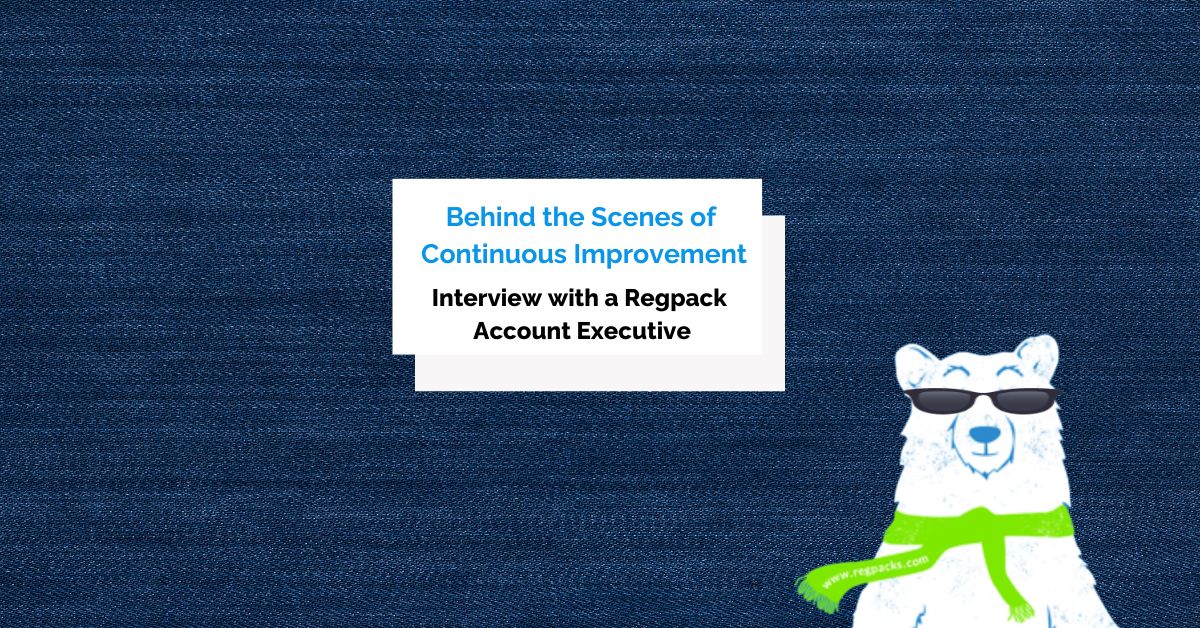Having a good customer onboarding strategy is more critical than ever.
You can have the best product in the market, the best, advanced features, and an incredibly intuitive UI, but it means nothing if your potential customers can’t get a grasp of it.
All your efforts are in vain if you ignore customer onboarding. Because if you do, then you’re going to become a part of 92% of SaaS companies that shut down because of low growth rates.
Nobody wants that, right?
Luckily, there are things you can do to improve your onboarding strategy. Continue reading to find out how to bring your customers a fantastic onboarding experience—in nine steps.
Jump to section:
Define Goals
Map Your Customer Journey
Choose an Onboarding Model
Decide Who’s in Charge of Onboarding
Create a Product Adoption Program
Keep an Eye on Your Users’ Status
Keep Communication Open
Measure Onboarding Success
Automate Customer Onboarding With Technology
1. Define Goals
A great customer onboarding strategy starts with clearly defined goals.
Have SMART goals to get your customers to their first Aha! Moment.
Setting up specific, measurable, achievable, relevant, and time-bound goals will help you guide them in their journey.
In this way, you’re ensuring their engagement and setting them up for future success.
While each company is different, it’s best to define multiple goals for different customers’ needs. Even if your product is simple, your customers won’t be.
People have various reasons for buying a product. They will demand personalization and excellent customer service, and it’s best if you have several different goals for your onboarding process to cater to other customer’s needs.
Most B2B SaaS products have a long justification period.
It usually takes up to 90 days for customers to reach lifetime value. During this period, churn rates are high, and you have to think about your onboarding flow through clearly defined goals.
Your onboarding goals should also align with your business needs.
Having a delegated team that will work on onboarding strategies is essential, and the skills they will need will depend on the type of product and the size of your company.
We’ll go into more detail about choosing a team in a later section.
Well-defined goals can help you and your team create an excellent onboarding experience for your customers.
2. Map Your Customer Onboarding Journey
Mapping your customer’s journey will help you get into their mindset and cater to their needs better.
Every onboarding journey is predictable to a degree.
There are specific steps every customer onboarding needs to have. They include sign-ups, welcome emails, initial interactive walkthroughs, and customer support.
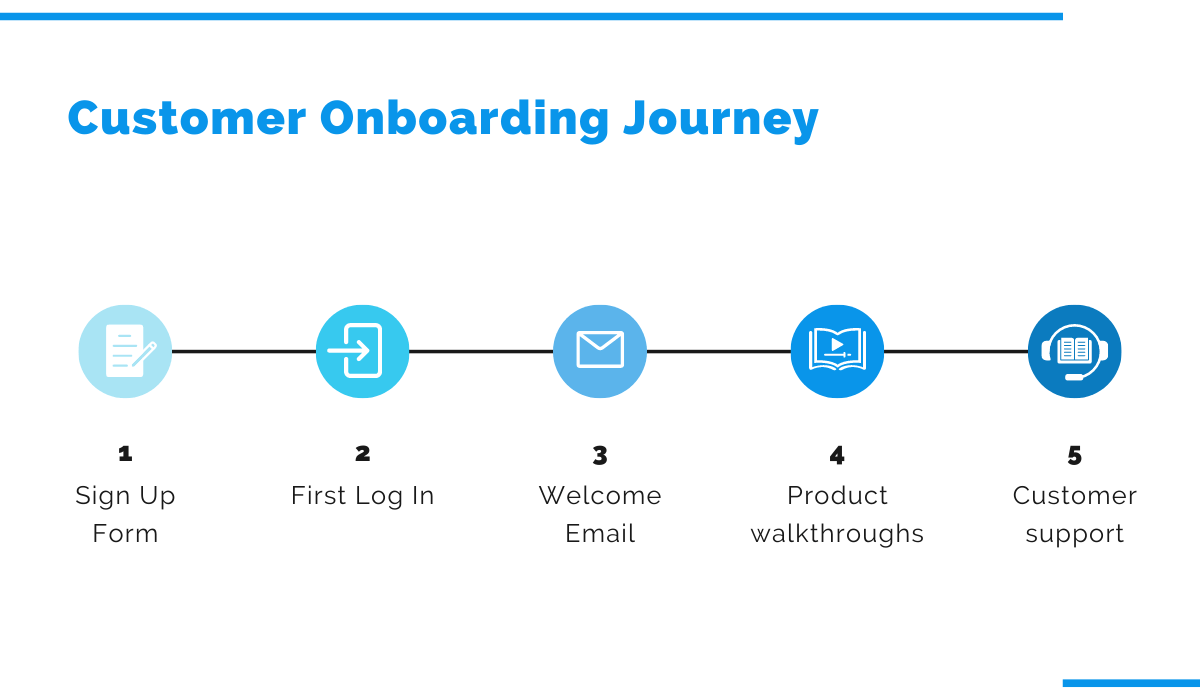
How you’ll approach each stage differs from company to company, but there are some things you need to keep in mind when you’re setting up phases of onboarding.
Think about the complexity of your software. How can you simplify the learning experience for your customers?
Your overall strategy should be to minimize the mental effort your customers have to put into the onboarding.
Your customers and your team need a straightforward path to reach their Aha! Moments at every step, but your onboarding team also needs objectives to clear that path for your customers.
They should be able to empathize with their mindsets.
Even after you’ve successfully mapped out the onboarding journey for your customers, you need to make continual adjustments.
Collect relevant data for each stage of your onboarding to improve. You can also collect feedback from your customers or ask your customer success team to look for inefficiencies.
There are bound to be some regular mishaps that you can improve on.
Remember, a customer’s onboarding journey is a process of predictable steps that focus on specific needs and goals.
3. Choose an Onboarding Model
The onboarding process is predictable, but there are different onboarding models for different onboarding strategies.
Pick one that best suits your ideal customer’s needs and your product.
The Self-Service Model
Companies with simple products or a B2C business model will benefit the most from this type because customers do everything on their own.
The setup is simple, and it takes the least amount of time to finish.
It’s also great for companies with a high volume of users. There is no need for a dedicated customer onboarding team, and the customer experience ratings are high.
The Low-Touch Model
This is the middle ground between self-service and hands-on customer service. It includes automated customer support like chat, in-app messaging, and emails.
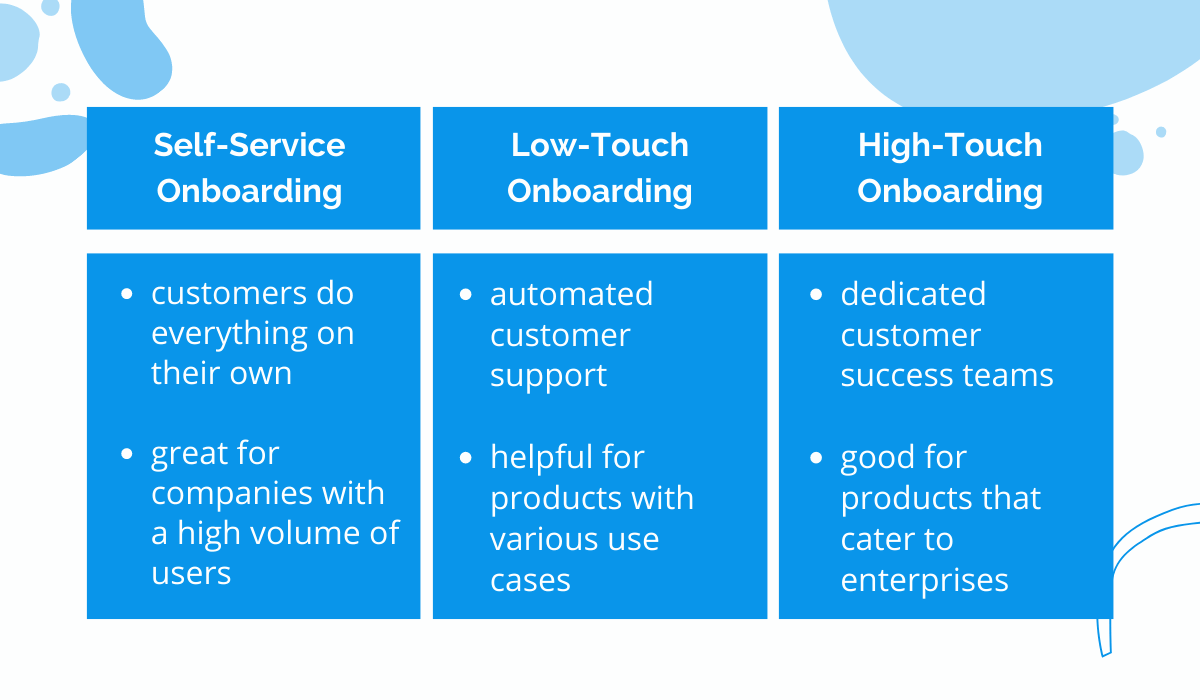
Companies with slightly more complex products that require more extensive explanation use this approach. It is also helpful for products with various use cases and small team users.
The High-Touch Model
This top approach includes dedicated customer success teams and highly personalized onboarding strategies.
Companies that use the high-touch model usually have products that cater to enterprises or introduce an entirely new user behavior.
With this approach, there’s a lot more at stake for successful product adoption, so the level of care is also higher. A major drawback to this approach is that it requires the most resources.
Overall, choosing a suitable onboarding model is a crucial factor in your overall onboarding success. Identify your core customer base and build your strategy from there.
4. Decide Who’s in Charge of the Onboarding Process
Once you make an onboarding plan and you decide on the best onboarding model for your business, make sure everyone on your team is familiar with it too.
Your customer success team will be there to personalize the experience, offer real-time troubleshooting strategies, and oversee the customer’s progress.
What makes a great customer success team?
Obviously, they are the main people who will ensure that onboarding is relevant for your customer’s needs, and they can take onboarding to the next level.
- Your customer success team should work closely with engineers and developers—people who build the product so they can target specific questions.
- They get in touch with product managers who know everything about the software and its capabilities and learn from them.
- Sales managers can help them with upsells by comparing the offers with their competitors, and executive leaders can oversee the company and the users’ satisfaction.
More and more companies are hiring onboarding specialists.
Their primary focus is maintaining customer relationships, and their duties might include support, account management, and sales.
When users have a single point of contact, they are more confident using your product, so the eventual lifetime value is reached much quicker.
They need to help customers on their onboarding journey and align their needs with the company’s goals.
Such teams are helpful for companies with complex products that require highly personalized onboarding, and they drive their vision to successful lifetime value.
Also, don’t neglect training sessions for your team.
To successfully help your customers, they need to know your product’s technical ins and outs to be better prepared to interact with your customers.
Good customer success teams are becoming the norm in many SaaS companies, and you should hire the right people to connect with your customers.
5. Create a Product Adoption Program
For successful product adoption, there need to be opportunities that lead to consecutive Aha! Moments. Engaging your customers is vital.
How do you do that?
Once your customers get familiar with your product on a basic level, you can expand on this by providing video tutorials and guides.
However, don’t stop at educating them about your product.
Another way to speed up product adoption is by celebrating the progress your users are making.
For every 20th email they send, and for every 5th picture they import, make sure you mark the milestone.
It’s like saying: “Look how much my software is helping you!” Look at how Todoist celebrates user’s progress:
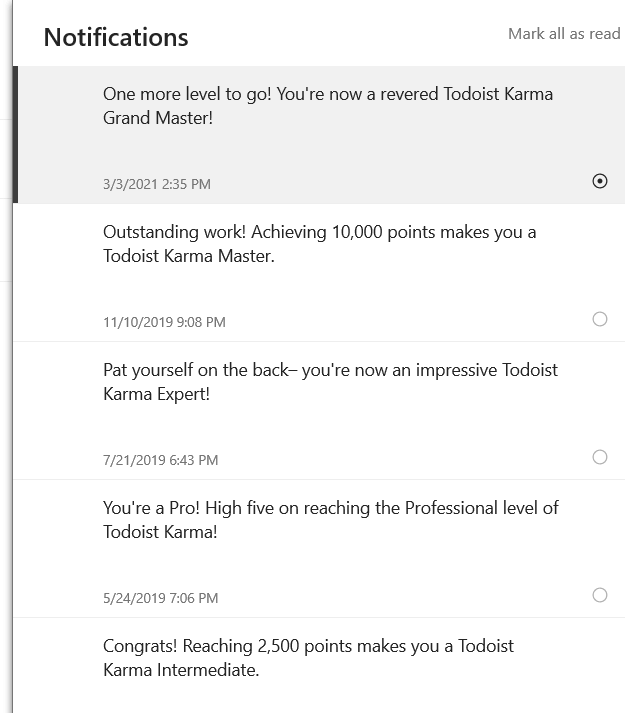
Another way to nurture your relationship with your customers is by using tool-tips and pop-ups.
Use these to showcase your newest features, news about your company, and other helpful information that will regularly direct their attention to your product.
Suggest ways users can make the most out of your product. Use different methods to keep your customers engaged and speed up product adoption.
Triggered emails and in-app messaging will also help you monitor your customer’s behavior.
That way, you can help them in real time and reduce churn that is likely to happen once they get too frustrated if something goes wrong.
6. Keep an Eye on Your Users’ Status
You should know at every moment during onboarding what your users are doing.
Use software that will help you analyze problem areas and levels of product adoption. In this way, you’re proactively working with your customers to improve your onboarding and your product.
If they consistently hit a roadblock, the problem might not be in your onboarding strategy but in your product.
Solving problems on a systemic level might be more helpful than focusing on an individual customer’s troubles.
As you gain more customers, you might want to develop a customer learning platform, which will give you a holistic view of all onboarding activities and allow you to monitor trends, as well as identify common problems.
It can also help your team better communicate with your customers.
Additionally, redesigning specific features and removing unused ones will go faster if you know exactly how users interact with your product.
To that end, data should flow seamlessly from one system to the next.
Nevertheless, even when your customer success rep helps your customer with a particular problem, there might be some underlying issues that remain unaddressed.
Undetected dissatisfaction can affect you once the renewal period comes, so you must continue keeping an eye on your customer to ensure the root causes of a problem are solved.
Tracking your customers’ use of your product will also help bring a new perspective to metrics analysis.
Keeping an eye on their behavior can help with customer retention and product adoption.
7. Keep Communication Open
While you must monitor your customer behavior for a better onboarding experience, you should also have open communication with users.
Communication should be maintained not only during the sign-up process but also as long as the person uses the product.
If people see they have someone to vent to about their problems, they’re more likely to remain a loyal customers.
The first 90 days after registration are crucial for product adoption, but they are also a starting point for your long-term retention strategies.
You want to get as much feedback from users in that period as possible.
Raw data often tells you little about the actual reasons users are behaving the way they are, but having an open line of communication, from customer service to survey feedback, can help you see specific successes and failures.
Your customer success team should also regularly review the available information and update you on your customer’s progress.
You can ask users questions in various formats—calls, surveys, social media, etc.
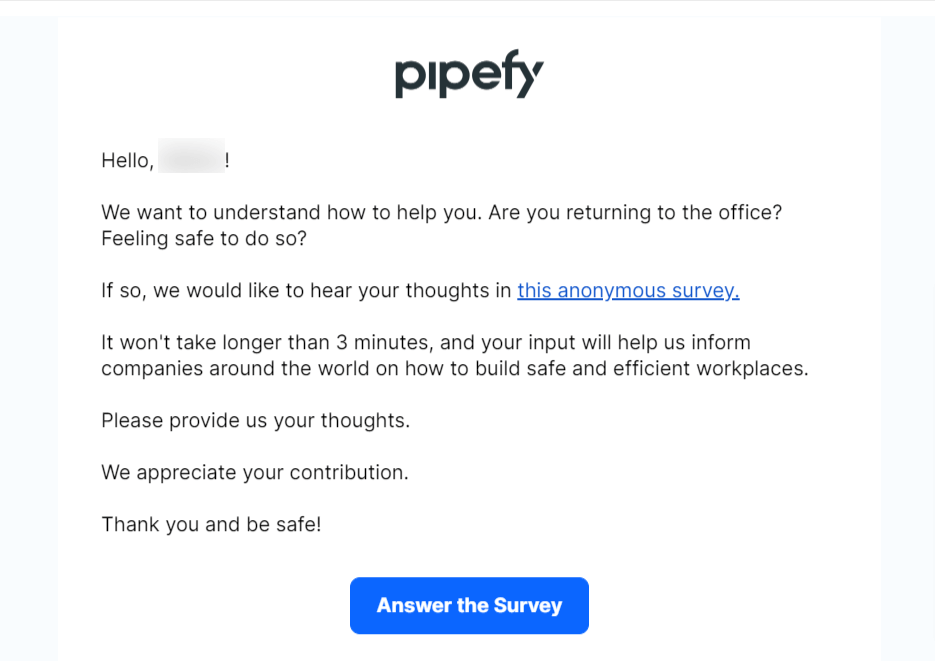
Even exit surveys are a valuable source of feedback, so check in regularly to see if your customers are still finding value in your product.
The biggest mistake you can make is not listening.
During support calls or emails, it’s easy to get ahead of yourself and simply list a wide variety of valuable sources, but ultimately, your customer knows best what their problems are, and you should do your best to listen.
The easiest way to gather feedback from your customers is by email, especially from inactive users.
You need to ask the right questions to connect with your users, convince them to stay with your product, as well as re-engage inactive ones.
Therefore, personalize those engagement emails in any way you can.
Keeping customers satisfied is an ongoing process, so open channels of communication to gather important feedback.
Not everyone might be articulate enough to highlight their pain points but don’t worry. With proper monitoring, you’ll be able to find solutions.
8. Measure Onboarding Success
To figure out if your onboarding strategy is reaping the right results, you have to focus on the relevant metrics and analyze your data.
Your users will determine the value of your product during their onboarding, while the data they provide will show you whether your efforts are effective.
Therefore, do your best to track the right metrics in order to spot any red flags and resolve them in a timely manner.
Choosing the right ones to measure your success is essential, so let’s go over some of the most significant ones.
Number of Users
It’s always helpful to know how many people are coming in.
This metric shows you how successful your company is in acquiring new customers and tells you you’re doing something right to attract them.
If not, you should change your acquisition strategy.
Time to First Value (TTFV)
This is where you prove your worth. If the customer reaches their first success or Aha! Moment in a short time, your onboarding is working.
Make sure to get to it as quickly as possible to retain the highest number of users.
Currently Active Users
Those who use your product regularly are your best source of feedback.
Your users are what’s keeping you in business, so it’s important to cater to their needs—and gather as much data about them as you can.
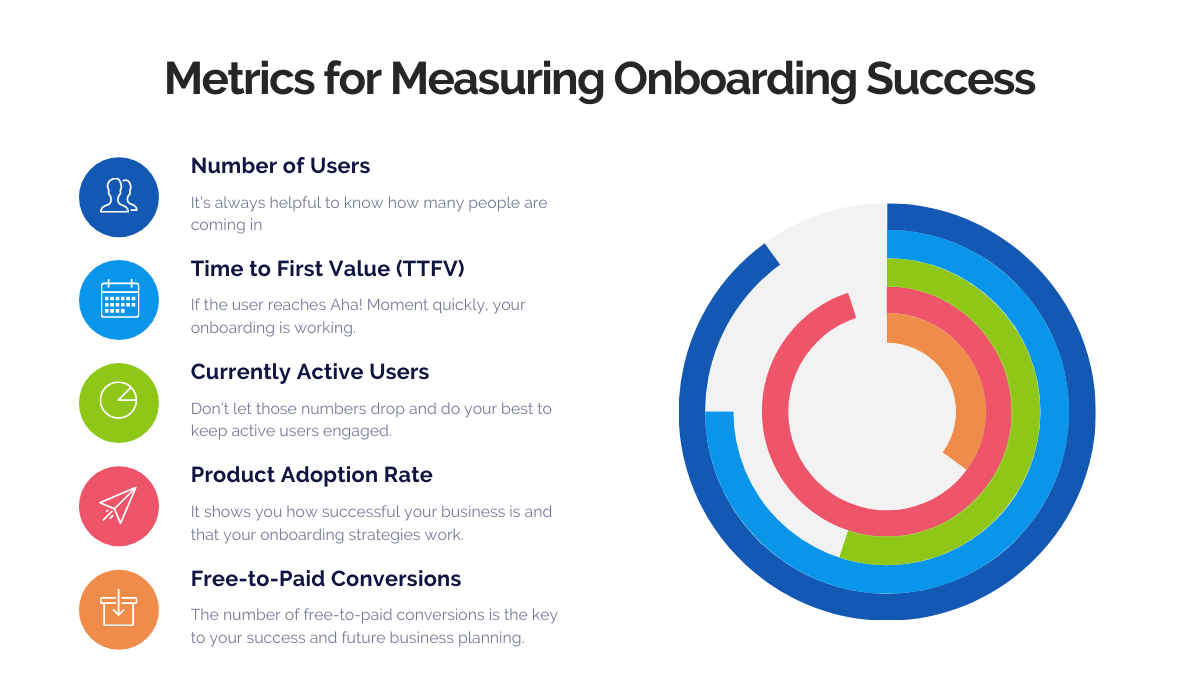
Don’t let those numbers drop and do your best to keep active users engaged.
Product Adoption Rate
After a series of quick wins, your customer will become hooked on your product. In the SaaS industry, that’s referred to as “stickiness.”
It’s the first metric that shows you how successful your business is and that your onboarding strategies work.
Monitoring your PAR will tell you about the effectiveness of your onboarding, and your team should do it regularly.
Free-to-Paid Conversions
Freemium plans are suitable for the initial taste of your product, but we all want those new users to move on from free trials and become paid users.
That’s what we’re in the SaaS business for, right?
The average conversion rates in SaaS are in the range of 30-35%.
The number of free-to-paid conversions is the key to your success and future business planning.
Great onboarding paves the way to those conversions, as it’s when you demonstrate your reliability to your users, so you shouldn’t neglect it.
Gather multiple metrics to have a holistic view of your onboarding process so that you can make sure you’re implementing the best practices.
9. Automate Customer Onboarding With Technology
Use technology to boost your onboarding process.
Onboarding needs to cater to each segment of your user base, and because you’ll likely be repeating it with each new customer, you’ll continuously have to improve it.
The easiest way to do this is to automate as much as you can.
Automation will cut costs and increase efficiency—but you should be careful it doesn’t come at the expense of a good user experience.
There are aspects of your business that are purely functional and don’t require a hands-on approach.
One of those aspects pertains to transactions. Automating payments, invoices, and receipts can save you a lot of time and effort.
Transactional emails are a necessity in SaaS, and you should do the most to make them as painless as possible.
If you have a customer-learning platform, utilize it to the max.
Help your team automate messages and send reminders when they engage with customers.
Manually processing each interaction with the customer can be time-consuming, so find automated solutions whenever possible.
Your team can handle the rest once they have the proper tools to initiate the first contact.
Here are some of the more popular automation tools.
Pre-Built Email Templates
While you should focus on personalizing onboarding, there are some tricks that you can use with templates to suit your needs and keep your relationship with your customers on a good note.
AI Chatbots for Support
Having a customer success team is beneficial in many ways, but what if you can’t have one?
Or, what if your team is wasting time answering the same basic questions over and over?
A live chat chatbot can help you solve some of the more routine problems, and you can even utilize them as a branding tool.
Advanced Timers
Your customers are going to be scattered all over the world. It might not be ideal to send them emails at 3 AM.
Specially programmed times will enable you to limit email campaigns to weekdays, at times when your customers are at work and can probably open them promptly.
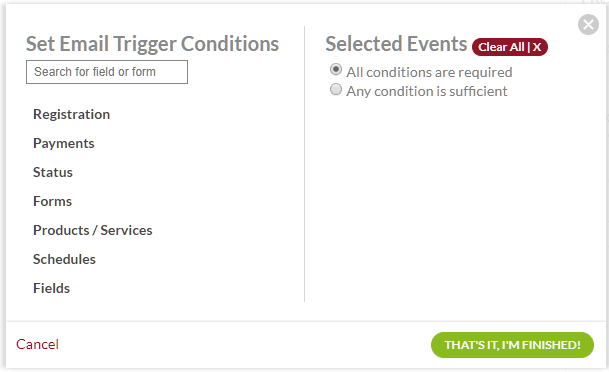
Automation is a life-saver for software companies because it reduces costs, improves efficiency, and makes SaaS onboarding smoother.
Use software solutions like RegPack to set your automated payments and billing, and focus on those that’s essential to keep your business running instead.
Conclusion
A good user onboarding strategy is what will ultimately keep you in business.
First, you need to define clear goals for your business and determine how your onboarding can contribute to them.
Your next and primary focus should be your customers.
The user base highly impacts the onboarding model you will use and determines which elements you will include while keeping the overall process simple and reliable.
You will solve most of your onboarding problems by keeping a close eye on user behavior, analyzing metrics, and gathering feedback through open communication with your customers.
In turn, that will help you reduce your churn rates and help your business grow.


